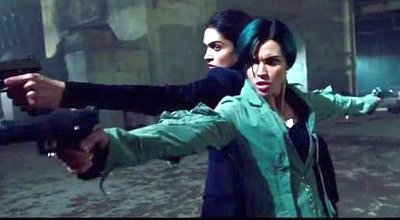(Originally posted May 17, 2017)
Whatever you may think about Vin Diesel's brand new chapter in the "XXX" series, XXX: RETURN OF XANDER CAGE (2016), it does serve a vital purpose.
Namely, to give my DVDs of all those cool hardcore action flicks from the 80s and 90s a breather. You know, back when they knew how to make kickass, uncomplicated, manly action epics that delivered the goods without taking themselves too seriously.
That's exactly what this--what's that word--"high octane" blast of damn-near nonstop action does from the very first minutes when Vin's Xander Cage character, whom we thought was dead but merely faked his death, starts out doing something wildly unbelievable which we know the movie's going to have to top. And which it most definitely will, repeatedly.
Eschewing the brawny military types assigned to him in the most exquisitely dismissive manner imaginable, Xander gathers his own team of badasses, each with his or her own special skills. They'll need them, too, because they're going up against an equally insane group of adversaries which includes the likes of both Tony Jaa (the ONG BOK series) and team leader Donnie Yen (KILL ZONE, IP MAN).
Needless to say, this paves the way for some of the most intense, mind-blowing action sequences in years, with excellent fight and stunt choreography, and direction (by D.J. Caruso, THE DISAPPOINTMENTS ROOM, DISTURBIA) and editing that make things snap without using too much Shaky-cam or incomprehensibly quick cuts.
This means we might as well go into it knowing that (a) Xander is going to be unbelievably, superhumanly cool and able to do anything, including jumping out of a doomed airplane without a parachute, and (b) the situations and dialogue are going to be totally over-the-top and, at times, a little bit dumb. But you know what? Sometimes dumb is fun, and vice versa.
So okay, XXX is the toughest, the most badass, the most virile (he plows his way through a whole group of sex-starved babes and leaves them all slumbering contentedly in the morning), the most insanely resourceful S.O.B. when the chips are down--basically, the most everything.
I'm sure some less enthusiastic viewers will be glad to point out all the ways in which this movie is unforgivably dumb. As for me, I love the gritty, highly improbable action, the rogue's gallery of fascinating characters (played by a terrific international cast), the dazzling fight choreography, the amazing stunts, the Bond-level gadgets, and the cool special effects (including, fittingly enough, some "iffy" wirework).
Mostly, I like XXX: RETURN OF XANDER CAGE because it's just plain fun, and will make a worthy addition to my roster of "go-to" old-school action flicks.
-----------
Tech Specs
This Paramount feature comes in a combo pack with Blu-ray and DVD discs along with a code to download a digital HD copy. The Blu-ray is presented in 1080p high definition with English Dolby Atmos (Dolby TrueHD compatible), French 5.1 Dolby Digital, Spanish 5.1 Dolby Digital, Portuguese 5.1 Dolby Digital and English Audio Description and English, English SDH, French, Spanish and Portuguese subtitles.
The DVD is presented in widescreen enhanced for 16:9 TVs with English 5.1 Dolby Digital, French 5.1 Dolby Digital, Spanish 5.1 Dolby Digital and English Audio Description and English, French, Spanish and Portuguese subtitles.
Bonuses on the Blu-ray consist of the featurettes "Third Time’s the Charm: Xander Returns", "Rebels, Tyrants & Ghosts: The Cast", "Opening Pandora’s Box: On Location", "I Live for This Sh#t!: Stunts", and a gag reel. The DVD contains the feature film in standard definition.
Street Date: May 2, 2017 (Digital HD)
May 16, 2017 (4K Ultra HD, Blu-ray, DVD, and VOD)
U.S. Rating: PG-13 for extended sequences of gunplay and violent action, and for sexual material and language
Canadian Rating: 14A violence, language may offend
http://www.ReturnOfXanderCage.com/
Twitter: https://twitter.com/xXxMovie
Facebook: https://www.facebook.com/ReturnOfXanderCageMovie
Instagram: https://www.instagram.com/xXxMovie
iTunes: http://j.mp/GetxXxNow
Amazon: http://j.mp/OwnxXxMovieNow






















































